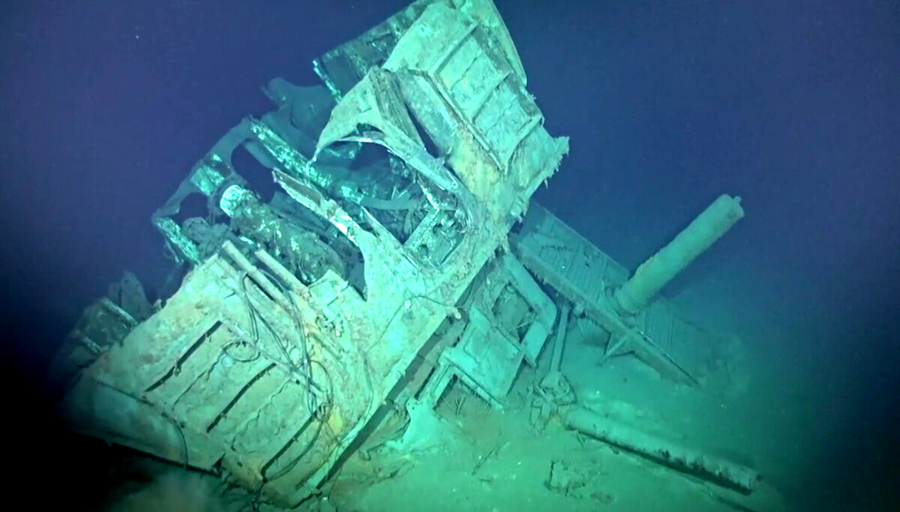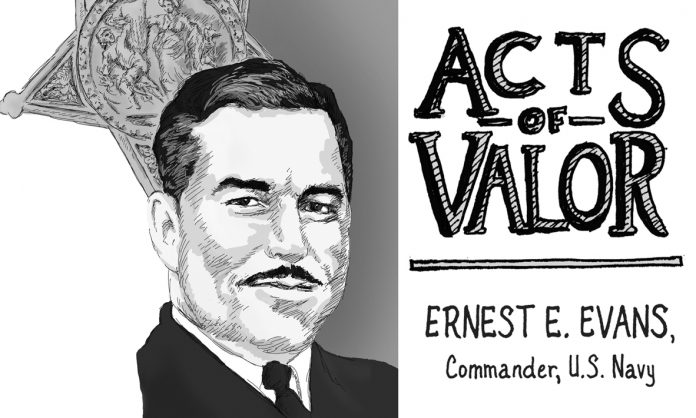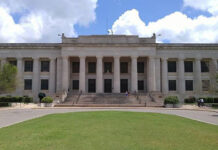Story and photos by Darl DeVault

May 31st is Memorial Day and Oklahoma’s Commander Ernest E. Evans is in the news again 76 years after his heroism and death at the hands of one of the largest Japanese naval armadas put afloat during World War II. His valiant actions in the Battle off Samar against a vastly superior force earned the Shawnee-born native American the only Medal of Honor awarded for this rare surface-ship battle in the war.
Evans’ ship, the U.S. Navy destroyer USS Johnston, was sunk in late October 1944 after he repeatedly hurled it against devastating firepower in the Philippine Sea. It was first found in 2019 after the deepest dive to a shipwreck in history. Only in the last month was it positively identified in a second dive by a different group of researchers.
Showing personal initiative, the brave commander was the first of a submarine screen of three destroyers defending six thin-hulled, lightly armed escort carriers loaded with planes. The Taffy 3 task force was attacked by an overwhelming 23-ship Japanese force coming to destroy the Leyte landing.
Upon first spotting the huge Japanese fleet and without orders, the Johnston threw out a smoke screen while sailing at flank speed against an enemy whose largest gun turret outweighed the U.S. destroyer. In a valiant action, Evans and his sailors were able to torpedo a Japanese cruiser while inspiring the other two destroyers to follow him against the enemy.
Evans received shrapnel wounds and lost two fingers when the bridge of his Fletcher-class destroyer was blown apart. The severely wounded U.S. Naval Academy graduate, who grew up in Oklahoma and graduated from Muskogee High School, continued to captain his damaged vessel in battle while shouting orders from the stern. The overwhelming Japanese force soon reduced the ship to dead in the water, and Evans and his sailors abandoned the sinking warship. The Johnston skipper was never found.
The Johnston crew’s bravery in this action, part of the wider-ranging Battle of Leyte Gulf, is credited with convincing the Japanese fleet that it was attacking a much larger force of aircraft carriers. The Japanese commander ordered an unnecessary withdrawal, saving the vital jeep carriers of the Taffy 3 force from certain annihilation.
The Japanese’s four battleships, including the super-battleship Yamato, eight cruisers and a dozen or more destroyers were in route to attack the 200,000 American soldiers of MacArthur’s 6th Army landing on the beaches of Leyte Island. The massive American armada assigned to defend this landing, the U. S. Third Fleet commanded by Admiral William “Bull” Halsey, had been lured away by empty Japanese carriers used as decoys.
In 2019, a few days past the 75th anniversary of the Battle off Samar, researchers from Vulcan Inc.’s research vessel R/V Petrel believed they had found wreckage from the engagement’s famed Fletcher-class destroyer, USS Johnston (DD-557).
Images of twisted metal, a destroyed deck gun, a propeller shaft, and other less recognizable debris were posted to Petrel’s Facebook page, with a video narrated by Rob Kraft, Vulcan’s director of subsea operations, and Paul Mayer a submersible pilot with the team started by the late billionaire philanthropist Paul Allen.
In late March of this year, a crewed submersible filmed, photographed and surveyed the wreckage of the Johnston off Samar Island on two eight-hour dives. A Texas-based undersea technology company Caladan Oceanic made the identifying dive. Company founder Victor Vescovo, who piloted the submersible, released dramatic video of the shipwreck.
“Just completed the deepest wreck dive in history, to find the main wreckage of the destroyer USS Johnston,” tweeted Vescovo, a former Naval officer.
“We located the front two-thirds of the ship, upright and intact, at a depth of 6,456 meters (21,180 feet),” Vescovo reported. “Three of us across two dives surveyed the vessel and gave respects to her brave crew.”
The expedition found the bow, bridge and mid-section of the Johnston intact, along with two full gun turrets, twin torpedo racks, and multiple gun mounts. The ship’s hull number “557” is still visible, according to a statement by Caladan Oceanic.
The shipwreck is a well-preserved tomb. From Johnston’s complement of 327 officers and men, only 141 were saved. Of the 186 men lost, about 50 were killed by enemy action and 45 later died from wounds floating in the ocean. Ninety-two men—like Cmdr. Evans—got off before the boat sank in shark-infested waters and were never seen again.
Evans’ Medal of Honor citation reads in part: The President of the United States of America, in the name of Congress, takes pride in presenting the Medal of Honor (Posthumously) to Commander Ernest Edwin “Chief” Evans (NSN: 0-70042), United States Navy, for conspicuous gallantry and intrepidity at the risk of his life above and beyond the call of duty as Commanding Officer of the U.S.S. JOHNSTON (DD-557) in action against major units of the enemy Japanese fleet during the battle off Samar on 25 October 1944. The first to lay a smokescreen and to open fire as an enemy task force, vastly superior in number, firepower and armor, rapidly approached. Commander Evans gallantly diverted the powerful blasts of hostile guns from the lightly armed and armored carriers under his protection, launching the first torpedo attack when the JOHNSTON came under straddling Japanese shellfire. Seriously wounded early in the engagement, Commander Evans, by his indomitable courage and brilliant professional skill, aided materially in turning back the enemy during a critical phase of the action. His valiant fighting spirit throughout this historic battle will venture as an inspiration to all who served with him.
There were many other brave sailors and airmen from the escort carriers during those three hours of standing toe to toe with the biggest warships ever built. Besides the Johnston, the destroyer USS Hoel was also lost in the engagement. The captain of the USS Heermann, the only U.S. destroyer that remained afloat, became the first destroyer captain to survive engaging multiple battleships in a daylight battle. Only losing four sailors, Commander Amos Hathaway was awarded the Navy Cross for his skillful seamanship.
These actions by the destroyers and those of many other sailors and pilots of Taffy 3 saved the Navy from a near disaster. In addition to all earning Presidential Unit Citations, the sailors and pilots earned 22 Navy Crosses, two Silver Stars and two Bronze Stars for valor in the battle.
Evans was inducted into the Oklahoma Military Hall of Fame in 2009. The following year the Oklahoma Historical Society published a long-overdue account of his life and heroics in a 2010 issue of the society’s historical journal, The Chronicles of Oklahoma.
Lt. Col. (ret.) Steve Reagan of Norman, Okla., has been raising funds for a memorial bust of Ernest Evans to commemorate this Native American naval hero from Oklahoma. The bust is planned to be located in Muskogee War Memorial Park. Anyone interested in information on these efforts or who would like to donate for this memorial should contact Steve Reagan at (405) 312-2270.














